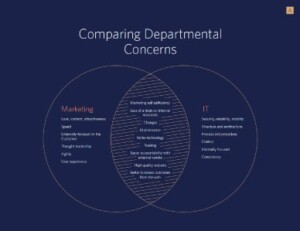Credit Union Website Design and Interdepartmental Collaboration
Find Valuable Common Ground Between Marketing & IT
Credit union website design can be challenging. Interdepartmental disconnect can make it an unfeasible struggle. Website improvements don’t need to be a battleground. Marketers, see how IT’s top concerns can actually align with your goals—if you use this guide to navigate those tricky conversations.
On one side, marketing squints into the sun with its regular demands for a credit union website design that delivers flexibility and speed. Your team needs to be quick on the draw and update the website as needs arise and meet your business goals. On the other side, IT resembles an immovable object, a constant rival wearing a black hat. With your every request, they stand tall in defense of preserving security and control at the cost of agility. With these opposing forces at a standstill, your website fades into the sunset and withers without any real improvements.
At financial institutions, this conflict only grows more pronounced. With stronger demands for legal and regulatory compliance, IT teams view security as the number one priority – and with good reason. However, as a result, credit unions are often saddled with slow, over-engineered sites that may be stable but frustrating to both your marketing efforts and your users.
Marketers: Your Conversation Starter Guide With IT

Working with your IT team during a site build can be challenging. Use this compiled list of common IT concerns to get ahead of issues before they start—and better navigate conversations with IT.
Fortunately, you have the means to find a truce. Rather than viewing every proposed website improvement request as high noon, you can better serve your business by embracing interdepartmental collaboration and working with IT rather than against them. By following a few tips, you can find the common ground that will clear a path toward a better website.

Understand that Marketing and IT Have Different Motives
Given the differences in perspective, it’s no surprise marketers find themselves at odds with IT teams when it comes to website improvements. Marketing demands – and rewards – websites that offer a strong impression, from their visual design to the targeted content and brisk performance that adds up to a positive user experience. To meet your goals, you’re squarely focused on the customer.
Conversely, IT teams hold your organization’s internal needs as the top priority. Along with ensuring your website remains secure and stable, IT managers see the structure of your site as the focal point.
While your team needs the flexibility to improve your site through API integrations and quickly launch new pages using component libraries, IT values control and consistency.
Ultimately, IT’s perspective isn’t wrong – an unreliable website is useless. But unfortunately, marketers waste a lot of energy viewing IT as an adversary. Rather than focusing on fighting for your priorities, your time is better served focusing on presenting a solution that satisfies both sides.
Highlight the Benefits of Sharing Website Duties
Historically, IT teams have managed their organization’s websites because digital platforms are built on technology. As the reach of digital has expanded, there’s a growing understanding that websites are more accurately viewed as a marketing channel like email or social media.
As technology has evolved, your website’s needs quickly outpace standard processes implemented by IT teams. Depending on your organization, you may find that the demanding nature of maintaining a website could lead to compromise.
For example, in our work with Virginia Credit Union, COLAB found the organization’s marketing team was hampered by a limited website. We made a case to the credit union’s IT team that appealed to their desires for consistency and scalability. They cared more about network infrastructure and no longer wanted the responsibility of maintaining an increasingly out-of-date website.
Once the marketing team addressed IT’s security concerns, IT was happy to cede their control over a portion of website management. In the end, we migrated the site to a new platform that better served marketing’s needs.
Your results in gaining more control over your website will in part depend on your organization’s culture. But if you recognize how the site’s resources can be shared, you can find a solution that’s right for both teams.

Embrace Interdepartmental Collaboration
To maintain a stable technological platform, IT teams place a premium on proven processes and procedures. Marketing, by contrast, values being able to turn on a dime and update its approaches as the need arises. Without the adequate resources to accommodate speed, IT will often rather cede control than absorb an uncomfortable level of risk.
Your organization and your website are best served by both sides coming together. Even if you feel IT’s input will slow your redesign efforts, you should still keep them involved in the decision-making.
In the end, your IT team may feel relieved to no longer remain solely responsible for managing an unwieldy website. But for the best results, you should remain transparent about the website design process. If you involve IT and address their key concerns – security, regulatory compliance, and stability – your design will be that much stronger.
Ultimately, no all-in-one solution exists that effectively grants exclusive control of your website to the marketing team or IT. However, by building a sense of trust with IT, you can continue relying on their expertise for areas of the site for a more effective partnership.
For instance, user login information and your credit union site’s ability to display APR rates hinges on your IT department. You can build a satisfying and secure user experience by balancing the features IT wants to own with those better served by marketing.
Join Forces to Present the Case for Website Improvements
As you look to gain approval for website improvements, you need to take a holistic view of the website’s capabilities. You can’t offer your executive team solutions that solely resolve your marketing problems. Your entire organization depends upon the website’s security and reliability, and you need to incorporate IT to address those concerns.
For instance, a marketer can look to a web form and consider a design to generate a result. IT, on the other hand, needs to know there’s a framework in place. Will the form reach the right representative? Do you have a process for escalation in place to ensure your customer receives a response?
By speaking IT’s language, you can present an integrated solution that satisfies every stakeholder. Then, you can use data about your site’s performance compared with its competitors to build a case for improvements. Outlining changes that serve your business goals while remaining safe and secure will make the strongest impression on your decision-makers.
When you satisfy IT department’s concerns, you can gain a powerful ally in pursuit of your goals. But the right digital design partner can help. At COLAB, we bridge the gap between marketing and IT teams to find processes that satisfy every need. If this sounds like an approach to ending the showdown that’s hampering your website’s progress, let’s talk.
